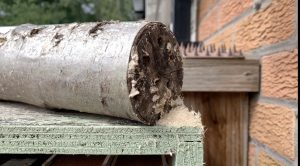Ectemnius solitary wasps
Although there are several species of Ectemnius solitary wasps in the UK, I think probably the ones in the film are male Ectemnius continuus. which according to Jeremy Early, are very similar in appearance is E. rupicola. This species (dark-gastered fly wolf) is found further south however with climate change this species may well move further north. Like other wasps, including social wasps, they provide protein in the form of insects for their larvae to feast upon. Ectemnius wasps are hunters of hoverflies and several other fly species. With their large heads, large eyes and large mandibles they are ideally equipped to hunt flies. After overpowering their prey, they sting it to immobilise it and possibly may also preserve it in some way to keep it fresh. They take the prey item back to the nest as food for their larvae, depositing several prey items before they lay an egg. They will also hunt solitary bees as you can see in this film although this bee was a little too large for the unsuccessful wasp!

Ectemnius solitary wasp excavations inside a rotten log
According to BWARS, they nest inside burrows within dead wood, such as old tree stumps, fallen trunks and limbs, fence posts, even building timbers. Wikipedia goes on to state they will also use rotting logs and sometimes building timbers or posts with the help of the mandibles when making a nest site. I watched one such wasp do exactly that inside an old rotten log I had drilled several holes inside to attract these wasps.
Decoy log
In the film, you will see the sawdust heap a female wasp excavated from the rotten decoy log. So that worked! Unfortunately, I could not film this. So I sprinkled this freshly excavated sawdust inside several of my nesting cavities and as there may well have been wasp mandible secretions on the shavings. I hope it may just be enough to temp (fool really!) a nesting female inside to nest. Not a chance! Having said that it and the sawdust may well have attracted females seeking males, who then used the nest box themselves to rest before they went out in search of females.
My Nurturing Nature solitary bee nest boxes are certainly not rotten wood! So I guess that all the specimens I have had using my nestbox over the years have either been males resting/sleeping/sheltering inside or females that are sheltering, sleeping but certainly not nesting.
Interesting article “The hoverfly hunting machine” by biologist Dr Africa Gomez
Another solitary wasp article by Dr Isabella Brey “Lone Wolves” which includes Ectemnius wasps.
Fabulous photos of males and females on Steven Falks Flickr pages.
Excellent photos here by Jeremy Early of Ectemnius wasps

Very timely. I was wondering about Ectemnius sp tackling bees as yesterday I saw one try to tackle a bee in mid-air. The bee dropped & shook off the wasp.
See this Tim. https://nurturing-nature.co.uk/wildlife-garden-videos/ectemnius-solitary-wasp-targets-solitary-bee-as-food-to-go/